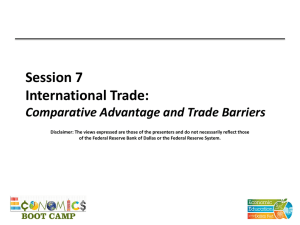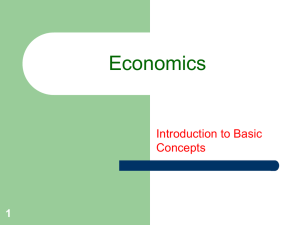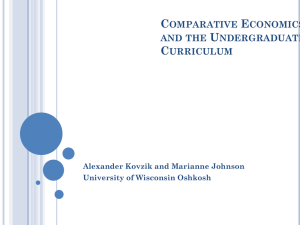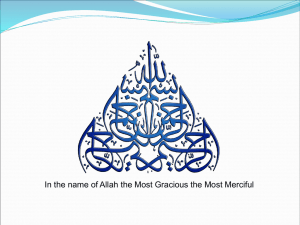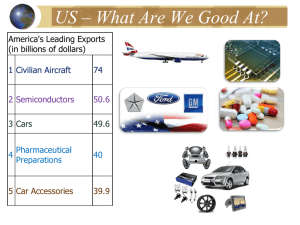Chapter 3 - Interdependence and the Gains From Trade
advertisement
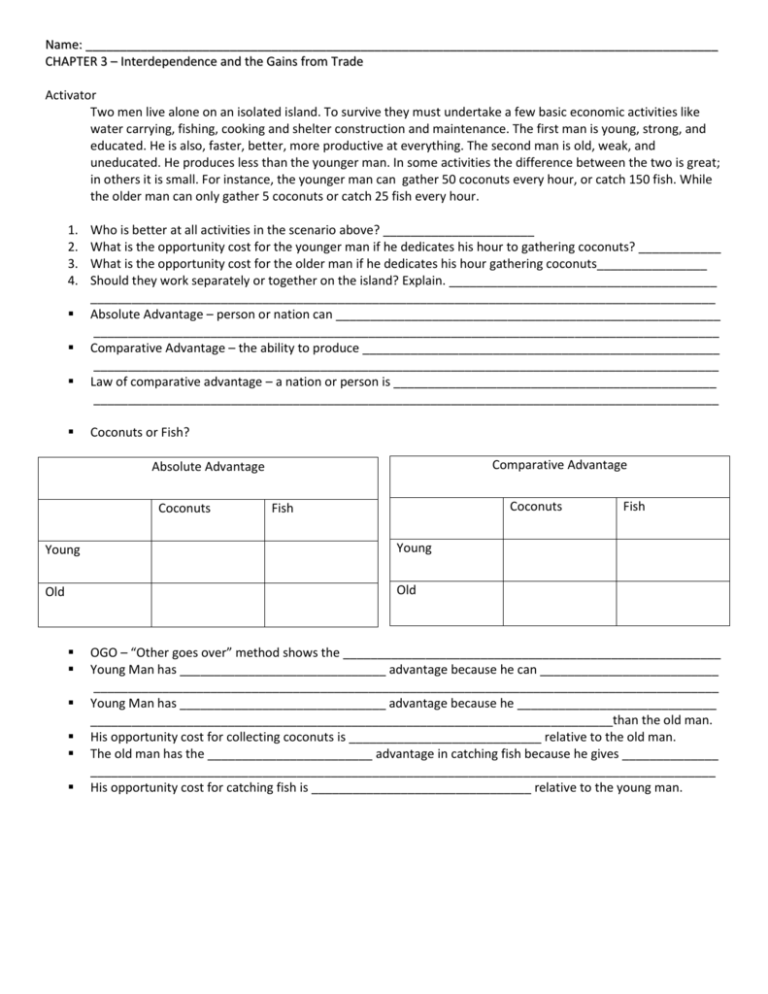
Name: ____________________________________________________________________________________________ CHAPTER 3 – Interdependence and the Gains from Trade Activator Two men live alone on an isolated island. To survive they must undertake a few basic economic activities like water carrying, fishing, cooking and shelter construction and maintenance. The first man is young, strong, and educated. He is also, faster, better, more productive at everything. The second man is old, weak, and uneducated. He produces less than the younger man. In some activities the difference between the two is great; in others it is small. For instance, the younger man can gather 50 coconuts every hour, or catch 150 fish. While the older man can only gather 5 coconuts or catch 25 fish every hour. 1. 2. 3. 4. Who is better at all activities in the scenario above? ______________________ What is the opportunity cost for the younger man if he dedicates his hour to gathering coconuts? ____________ What is the opportunity cost for the older man if he dedicates his hour gathering coconuts________________ Should they work separately or together on the island? Explain. _______________________________________ ___________________________________________________________________________________________ Absolute Advantage – person or nation can ________________________________________________________ ___________________________________________________________________________________________ Comparative Advantage – the ability to produce ____________________________________________________ ___________________________________________________________________________________________ Law of comparative advantage – a nation or person is _______________________________________________ ___________________________________________________________________________________________ Coconuts or Fish? Comparative Advantage Absolute Advantage Coconuts Coconuts Fish Young Young Old Old Fish OGO – “Other goes over” method shows the _______________________________________________________ Young Man has ______________________________ advantage because he can __________________________ ___________________________________________________________________________________________ Young Man has ______________________________ advantage because he _____________________________ ____________________________________________________________________________than the old man. His opportunity cost for collecting coconuts is ____________________________ relative to the old man. The old man has the ________________________ advantage in catching fish because he gives ______________ ___________________________________________________________________________________________ His opportunity cost for catching fish is ________________________________ relative to the young man. Steps for Determining Comparative Advantage o Scenario: Canada and Mexico are considering the trade of two goods. Canada can produce 100 Furs or 100 trees. Mexico can produce 50 furs or 200 trees. Step 1 – Input the Data Productive Output Fur Trees Canada Mexico Step 2 – Find the Opportunity Cost of Production Opportunity Cost Fur Trees Canada _____ ÷_____ = _____ _____ ÷_____ = _____ Mexico _____ ÷_____ = _____ _____ ÷_____ = _____ Step 3 – Analyze the data to determine comparative advantage • • • • • It costs Canada ______ fur for every tree it produces. It costs Mexico ______ fur for every tree it produces. It costs Canada ______ tree for every fur it produces. It costs Mexico ______ tree for every fur it produces. Therefore, ____________________________ should specialize in the production of Fur, while _____________________________ should specialize in the production of trees Kate and Carl Productivity Per Hour T-Shirts per hour Birdhouses per hour Kate 6 _____ ÷_____ = _____ 2_____ ÷_____ = _____ Carl 1 _____ ÷_____ = _____ 1 _____ ÷_____ = _____ Who has absolute advantage in this situation? It costs Kate ________ birdhouses to produce 1 t-shirt. It costs Kate ________ shirts to produce 1 birdhouse. It costs Carl ________ to produce 1 t-shirt. It costs Carl ________to produce 1 birdhouse. ________ has a comparative advantage when producing t-shirts. ________ has a comparative advantage when producing birdhouses. Therefore, ___________ should produce t-shirts and __________ should produce birdhouses. Application Questions – pgs. 58 – 59 Should Tiger Woods Mow His Own Lawn? 1. What does Tiger Woods hold an absolute advantage in? __________________________________________ 2. What does Forrest Gump have a comparative advantage in? _______________________________________ 3. What is the opportunity cost for both Tiger and Forrest for mowing the lawn?_________________________ ________________________________________________________________________________________ 4. Why are the gains from trade beneficial in this scenario?__________________________________________ Should The United States Trade With Other Countries? Create a chart to show the production of cars and food in the U.S. and Japan. Productivity Cars per month Tons of food per month US _____ ÷_____ = _____ _____ ÷_____ = _____ Japan _____ ÷_____ = _____ _____ ÷_____ = _____ 1. 2. 3. 4. What is the opportunity cost for both countries production of cars and food? o Japan 1 ton of food or _________________ car per month. o US 2 tons of food per month or _________________ car per month. Who has a comparative advantage in the production of each? o Cars _________________________________________ o Food _________________________________________ Application Question Comparative Advantage A Japanese worker can produce 6 units of steel or 3 televisions per hour. A South Korean worker can produce 8 units of steel or 2 televisions per hour. Determine opportunity cost for each country using the table below. Create two graphs that summarize all the possible choices that they can produce. Indicate the absolute and comparative advantage based on the table below. What should be the range of prices at which each country would be willing to exchange? o Japan ___________ Korea ____________ Productivity Steel per hour TVs per hour Japan _____ ÷_____ = _____ _____ ÷_____ = _____ Korea _____ ÷_____ = _____ _____ ÷_____ = _____ Application Question cont… Steel Steel Japan TVs Korea TVs Gains from Trade: Suppose that Japan and South Korea settle on a trading price of 3 units of steel for 1 television (or 1/3 of a television for 1 unit of steel). Plot the new points based on gains from trade 1. Japan produces 3 TVs, exporting 1 for 3 units of steel. 2. South Korea produces 8 units of steel, and exports 3 units for 1 television, this allows them to consume 5 units of steel and 1 television. What were the gains from trade? Japan __________________ South Korea __________________ Gains from trade Application 1. Two people are academics who are paid for how many papers they produce. In one year Jane can write 4 economics papers or 6 law papers. John can write 3 economics papers or 1 law paper. They need to figure out who should be the lawyer and who should be the economist. Create two graphs that summarize all the possible choices that they can produce. Then determine opportunity cost in the chart below Economics Papers Productivity Per Year Economics Papers Law Papers Jane John Economics Papers Economics Papers Jane • • • Law Papers John Law Papers They end up producing a total of 9 papers, 6 law papers and 3 economics papers. They decide to trade one law paper for one of economics papers; Jane ends up with 5 law papers and 1 economics paper while John can have 1 law paper and 2 economics papers Plot the new points on the above PPFs. What were the gains from trade? ___________________________________________________________
